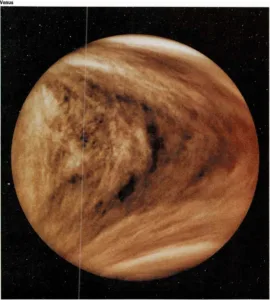

Earth’s “twin”
The second closest planet to the sun is Venus. Seen from the earth, it
is the brightest of all the stars and planets in our sky. Sometimes it
can even be seen in daylight. Because of its beauty, it was named after
the Roman goddess of love and beauty.
Venus is nearly the same size as the earth and is often called the
earth’s “twin.” But Venus is really nothing at all like our world.
Like the earth, Venus has an atmosphere—but the “air” of Venus is full
of poisonous gases. It is filled with such thick clouds that we can’t
see the surface of the planet. These clouds contain droplets of sulfuric
acid—a chemical so strong it can dissolve metal!
High in Venus’ atmosphere, there are terrible windstorms, with winds
that blow harder than the strongest humcanes on earth. The sky is lit by
constant flickers of lightning that flash as often as twenty times a
minute.
Because Venus is always hidden by clouds, scientists have used
spacecraft to photograph its surface and test its soil. We now know that
the surface of Venus is so hot it would melt lead. There is no water,
nor any other liquid, anywhere. Much of the surface is a huge, rolling
plain, but there are also great mountains, long and deep canyons, and
big and small volcanoes, some of which may be active.
Venus is about 67 million miles (108 million kilometers) from the sun.
Its year is as long as 225 of our days. But its day is as long as 243 of
our days. On Venus, a day is longer than a year!

